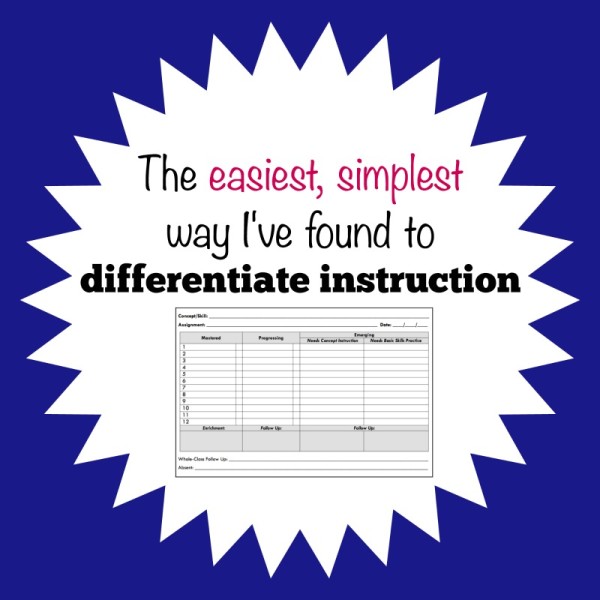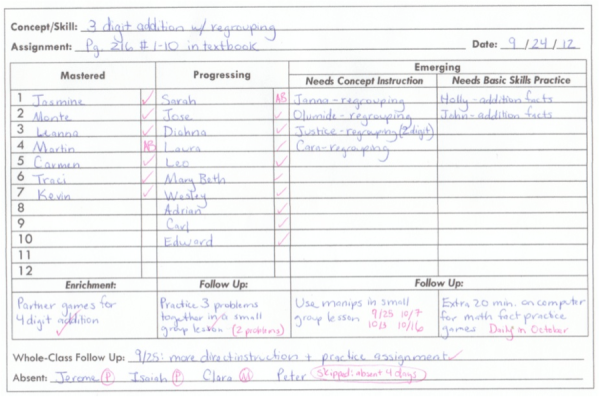Many of us educators are keeping a little secret about differentiating instruction. We believe it’s a good idea in theory, we try to do it when we can…but we really don’t have any workable system for differentiating. No one really knows how it’s supposed to be done, and the only ideas we’ve had so far are nearly impossible for one teacher to implement for 30+ kids.
Several recent articles have examined the logistical problems of differentiation in depth. Differentiation exists in most forms as a buzzword school systems employ to make it sound like one teacher can create optimal, personalized learning conditions happen for every student, even though it’s not actually happening on any sustainable level. I particularly like the statement made by James Delisle:
It seems that, when it comes to differentiation, teachers are either not doing it at all, or beating themselves up for not doing it as well as they’re supposed to be doing it. Either way, the verdict is clear: Differentiation is a promise unfulfilled, a boondoggle of massive proportions.
Don’t get me wrong–I believe differentiation is an essential step in assessing individual class performance accurately. It helps you recognize who’s falling behind in the class and helps you create the next steps in addressing the issue on an individual and group level. However, most methods of differentiation are overly complex and incredibly time-consuming.

I wanted an easy system for tracking and documenting individual student progress along with the class progress as a whole. I didn’t want to give kids grades on concepts I’d just introduced, but I needed to see how well they they understood so far, document their learning, and plan appropriate next steps.
So, I developed the Quick Skill Assessment Form.
I used it a few times a week to assess the work students did independently, usually for written assignments in math, but also in other subject areas as needed.
I’ll explain the system in detail so you can create it yourself, or save time/energy and purchase my ready-to-use form (which is now editable!)
The Quick Skill Assessment form is an informal method of assessment that makes it easy to:
- Give students immediate feedback
- Correct any misconceptions right away
- Reduce the number of papers that need to be graded
- Get a clear insight on how effective your lessons have been
- Plan the rest of your unit lessons based on how well the class understands the current skill
- Determine differentiated follow-up tasks for every student
- Keep detailed records of student progress with very little time and effort
The form can be used with any assignment, but it’s especially useful for:
- New skills you just introduced that day so you can set the pace for the rest of the unit
- Mid-unit assessments for ongoing skill instruction
- Concepts you teach only briefly (therefore no need for a formal assessment)
- Common Core or key skills that require you to document progress and interventions
- Any skills or concepts you’d like to evaluate without testing or without giving a formal grade
Check out the completed form example below. The writings in blue are made right after checking each student’s work, while the comments in red ink are written in the proceeding days as follow-up.
To use this system, just print out the form. As students finish an assignment, have them bring it over for you to check. Record a score in your grade book only if needed. Then write the student’s name in the appropriate column in the form to document their learning and plan your next steps.
The form has four primary columns explained in detail below. Below each column is a space where you will indicate the follow-up activity, with exception to the Mastered column which is followed by a space for an enrichment activity.
Mastered
In this example, 7 kids showed mastery of the concept, getting all or almost all of the problems correct. These kids proceeded with partner games that allowed them to practice a more challenging skill. I put a check mark next to each student’s name when they participated in that enrichment, and an AB next to Martin’s name to indicate he was absent during it.
Progressing
10 kids are marked as progressing: they got the majority of problems right but still need a bit more practice. For their follow up, I worked with them in a small group (while the kids who had mastered the skill were playing the partner game) and modeled how to solve additional problems. My plan was to practice 3 problems, but we had time for 2 problems only which I indicated in red. Again, I marked those present with a check and an AB for one who wasn’t.
Emerging: Needs Concept Instruction
Students under this group needed a lot more concept instruction (they missed the majority of the problems in the assignment.) Most got confused with 3 digit regrouping but one (Justice) was not able to regroup even with 2 digits. I indicated that on the form and followed up by practicing regrouping in small group settings. Each time I conducted one of those small groups, I wrote the date in the follow-up box as documentation.
Emerging: Needs Basic Skills Practice
2 students missed the majority of problems in the assignment because they needed basic skills practice. In this case, they were not able to add numbers correctly and therefore weren’t ready for regrouping. As follow-up, I planned to put those students who were still learning basic addition facts on the computer to play a game through the school’s math software program. Later I went back and added that this occurred daily throughout the month of October.
Whole-Class Follow Up
Since only 7 kids in the class demonstrated mastery in 3 digit addition with regrouping, I chose to revisit the concept again in the following day’s lesson. Once more kids have mastered the concept, I might choose to write “N/A” in the whole-class follow up section, or put “review/reinforce throughout the year.”
Absent
Here I wrote the names of all the students who weren’t in the classroom when the assignment was given. Later on, I had the absent students make up the work, and I wrote the results in red. Jerome and Isaiah have a circled “P” next to their names as they showed they were Progressing, and Clara has a circled “M” next to her name as she demonstrated Mastery. I indicated that I skipped this assignment with Peter, as he was absent for 4 days and I determined this particular assignment didn’t need to be made up.
By popular request, I made this form available in a full page version (for those with larger class sizes) AND a Word doc version is now included so it’s completely EDITABLE!
Hundreds of teachers have used this system successfully and it’s made their differentiation and assessment a LOT simpler:
Have found this very useful, especially for formative assessment! –Agata
This is my second year using this resource. It is so amazingly simple to use. Really cuts down on my bookkeeping! –Valerie
This product saved me hours of trying to develop these forms. –Paulette
These sheets are absolutely wonderful! I have found myself using them for EVERYTHING! They help me note who has mastered a skill, and when I did the reteaching for those who did not meet the standards. They are amazing. thank you! –Rebecca
This will streamline my individual, group, and informal assessments. I feel so efficient and organized now! –Arden
Such a simple and easy way to change my assessment practices…why didn’t I think of this before? –Anonymous
Like the layout–I can read data with a quick glance. –Melissa
LOVE, LOVE, LOVE this!!! It is used on a regular basis and I am able to see a snapshot of the class. I have tried everything from post-its, to labels, to index cards and this is the best by far! –Brigette
I hope it’s helpful for, you, too! Have you found any easy to manage systems for differentiation? Please share your thoughts in the comments!

Angela Watson
Founder and Writer
Sign up to get new Truth for Teachers articles in your inbox
Discussion
OR

Join our
community
of educators
If you are a teacher who is interested in contributing to the Truth for Teachers website, please click here for more information.


















Is it okay if I post a link to this on my blog? This is such a great idea and so simple to use!